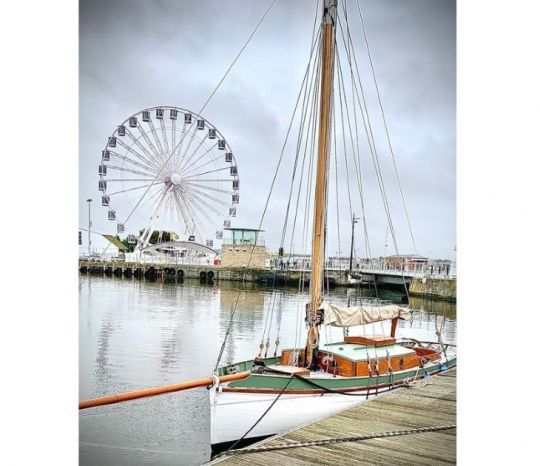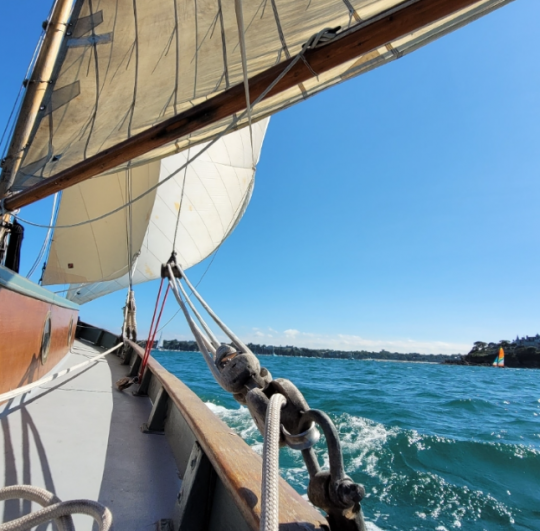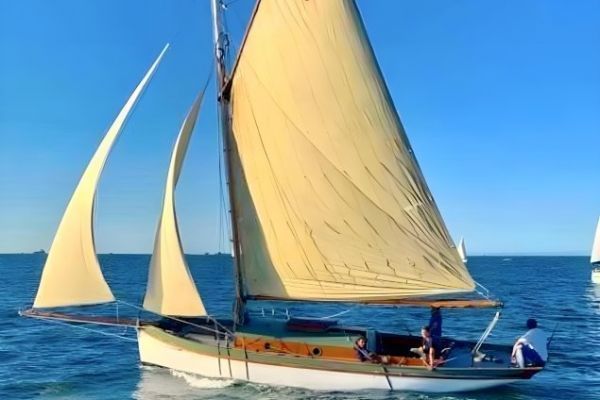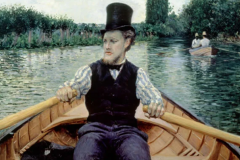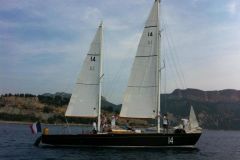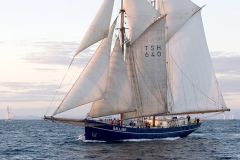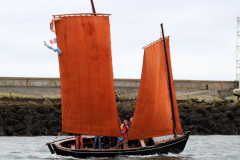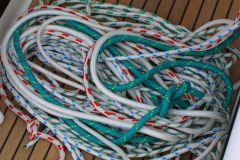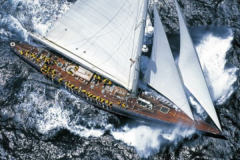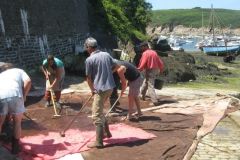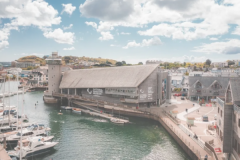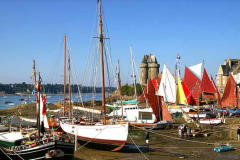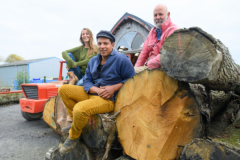In 2018, airline pilot Jean Bertrand embarks on an unexpected adventure when he acquires a boat named Madeline, without really measuring its heritage value. As the Covid-19 pandemic paralyzes the world, Bertrand seizes the opportunity to bring his sailing dream to life by refitting her, a project that will last three years. Supported by his brothers, he brings Madeline back to life, a small Smack from the East of England, which has braved waters and eras, titillating the shallows of the River Colne. With 125 years on the clock, Madeline, which will be awarded the BIP (Bateau d'Intérêt Patrimonial) label in 2023, would stand out as the oldest fishing boat to fly the French flag.
Finding the right buyer
Imported to France in 2003, Madeline passed through several owners before landing at the Étoile Marine shipyard in Saint-Malo, where she patiently awaits a new destiny, tucked away at the back of a shed. In 2014, Stéphane De Marquette, seduced by Madeline's curves, acquired her.
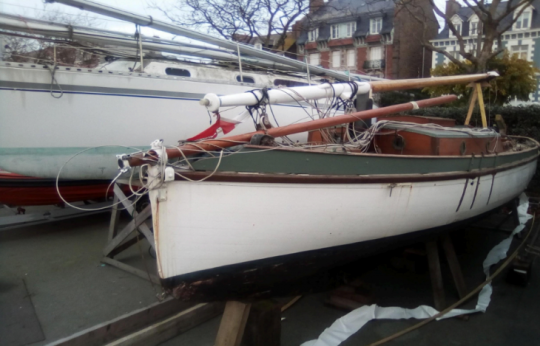
After a few renovations, the refitted yacht is finally ready to take to the sea again. '' It was at this time that Stéphane De Marquette asked me to accompany him. He knew of my passion for these very special rigs. Madeline was a pleasure to work with, and these few outings in light weather were a real pleasure recalls Jean, the new owner.
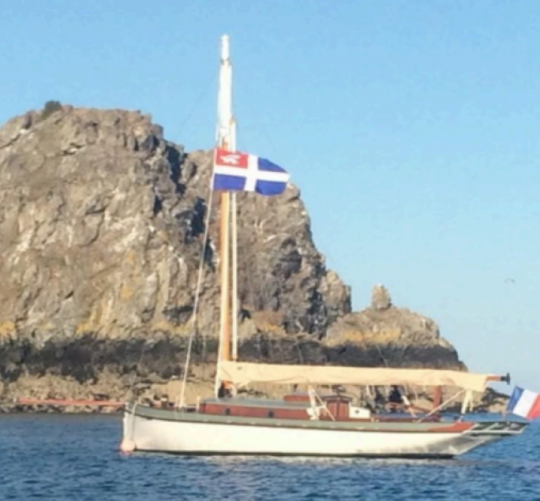
In 2018, Jean Bertrand officially took up the torch. After undertaking extensive research into the boat's origins, he is determined to preserve Madeline's soul and history for generations to come. Jean Bertrand has a clear goal: to have Madeline labeled a BIP (Bateau d'Intérêt Patrimonial), in order to secure her future and guarantee that she will continue to sail over the years.
A meticulous investigation
'' The first challenge was to prove that this auric-rigged boat was as old as it was claimed to be explains Jean. The OGA Boat Register Editor was contacted and a great deal of research was carried out. Correspondence with one of the former owners, John Hugget, who had bought the boat in 1984 in Woodbridge, revealed that Madeline had been built in the 1890s, probably in a shipyard located in Great Yarmouth, Lowestoft or Norfolk Broads in the Norfolk County area of eastern England. Modifications made by John Hugget, such as the addition of bulwarks, have been documented, providing clues to the boat's evolution over time. Records from Gaffer's Log then confirmed references to Madeline, including her participation in the East Coast Race in 1987 and 1988, linking the various records and confirming the authenticity of Jean Bertrand's yacht.
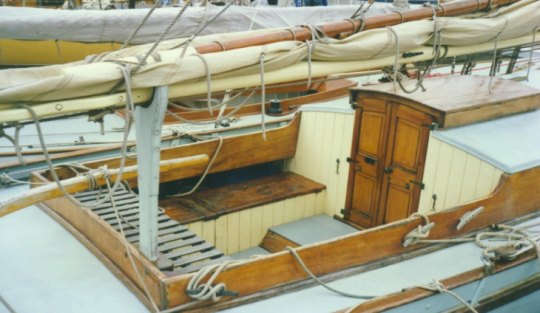
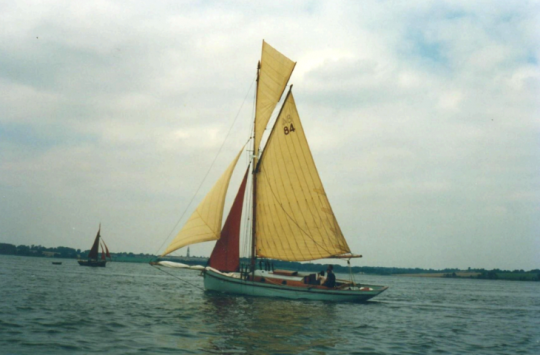
After consulting the notice of sale dating from 1977, it turned out that Madeline had been built in 1898 by James Brightlingsea, whose shipyard, J.W James, was located at the mouth of the River Colne in the county of Essex, in the east of England. This discovery helped Jean understand the importance of Smacks in the region. The River Colne was an iconic location for these boats, and by the 1970s, enthusiasts had founded the Colne Smack Preservation Society to preserve and celebrate this maritime heritage.

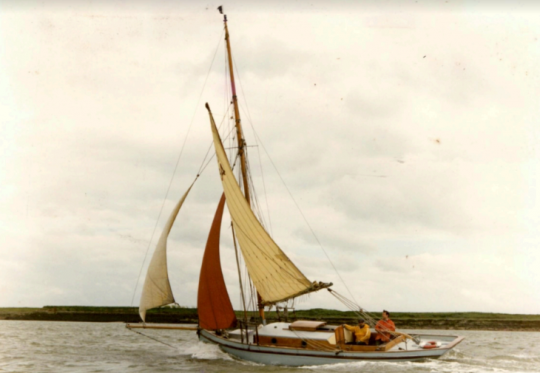
Research into the last English owner, Hector John Barr, who owned the sail loft at Wivenhoe in Sussex where the Nottage Maritime Institute is now housed, is said to have been in possession of Madeline for some fifteen years, before selling her in 1947. Extensive investigations at the Nottage Institute archives revealed that Madeline had been used as a fishing boat during the Second World War, and had received a fishing license. This discovery was a real consecration, marking an emotional moment for her current owner.
In 2023, thanks to several months' research, Madeline was awarded the BIP label, an honor that would underline her potential status as the oldest fishing boat to fly the French flag. Dating back to 1898, in 2024 she had accumulated 126 years of navigation.
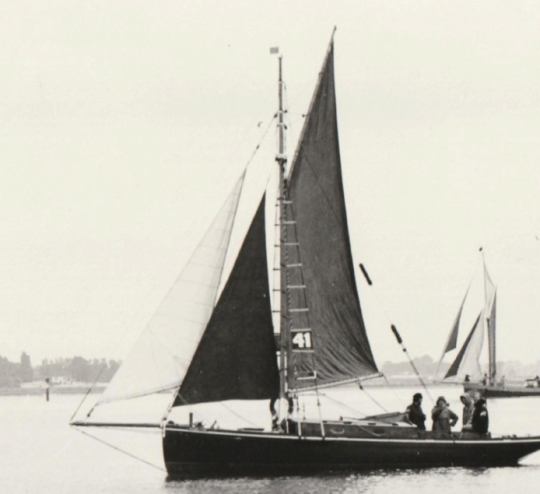
What is a Smack?
The term Smack "refers to a type of boat that has evolved over time, and whose origins date back to the period of Dutch maritime domination in the 16th century. At that time, major advances in shipbuilding accompanied the emergence of maritime trade. These advances were supported by the construction of canals and the expansion of land reclaimed from the sea, stimulating the development of new ship types to meet the growing needs of trade. Smacks were among these innovations.
The architecture of Smacks was characterized by a sturdy hull and specific sails, including the sprit sail, which enabled the ships to sail better to windward. The term smak "or " schmack "This modern sail was positioned at the bow and stern of the ship. The first Smacks were open vessels without decks, used mainly for fishing and transporting goods in shallow waters along the North Sea and Baltic Sea coasts.
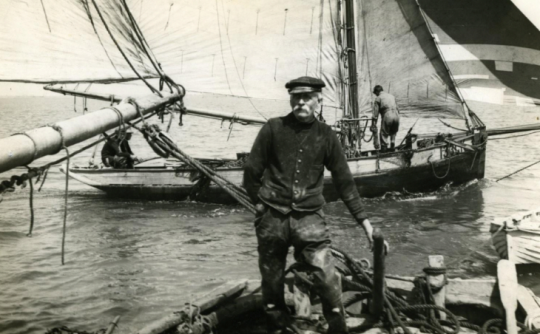
Over time, Smacks evolved into fast, all-weather boats. Their design also made them suitable for sheltering the crew in bad weather. Subsequently, the restored hulls of the Smacks were much sought-after by pleasure sailboat enthusiasts. This type of boat is now assimilated to the English cutter. To be suitable for pleasure sailing, a gaff cutter must have a balanced hull with a keel of sufficient length. The bow tip should not be too short, enabling the boat to maneuver efficiently both upwind and in a swell, while maintaining a constant course without requiring excessive effort on the part of the helmsman.
The restoration of Madeline
In winter 2018, a strong westerly depression hits Saint-Malo, causing severe damage to the boat. Faced with the scale of the repairs required, Stéphane De Marquette offers Jean the chance to take her over. After a thorough appraisal, Jean finally accepted the offer. Three years of work then went into restoring Madeline. Jean says: " I already had some experience of old rigs, notably with La Malouine, but also with Lord Will Sutherland, which I seconded for 4 years. At the request of her former owner, I sailed on Madeline to share my experience of the classics maybe 3 or 4 times before. I saw the potential in this little smack. I know how to sail these boats, but I don't know how to repair them. I'm not a marine carpenter. So I learned the basics from books like Entretenir et restaurer les bateaux en bois, special edition of Le Chasse-Marée. I also watched a lot of YouTube channels. Tips from a shipwright, Tally ho, The art of boat building... When I started out, the scope of the work was overwhelming. And where to start? Every time we removed something rotten, we found something rotten behind it. Psychologically, it's pretty tough. But you have to be patient and take it philosophically. At some point, you enter a second phase: yesterday's deconstruction gives way to tomorrow's reconstruction. It's very satisfying. "
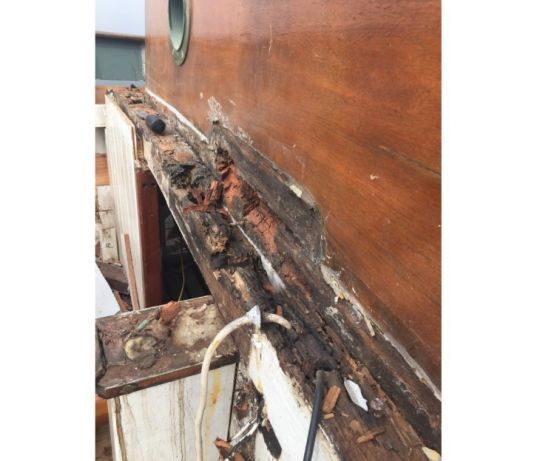
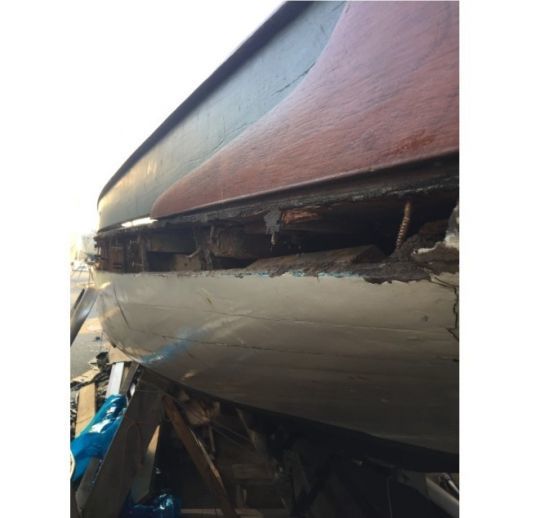
Finally, in June 2023, the ship was put back in the water to finally set sail again. Post-restoration, the pitch-pine hull now appears to be in excellent condition. With 15 planks of 20 mm on each side and a slightly thicker forefoot (25 mm), it was restored between 2020 and 2022.
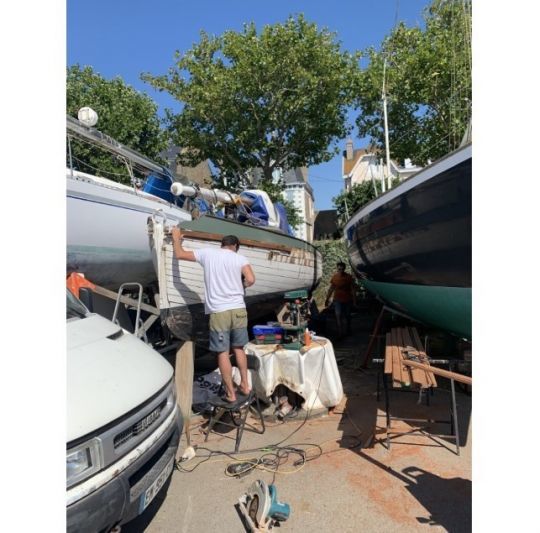
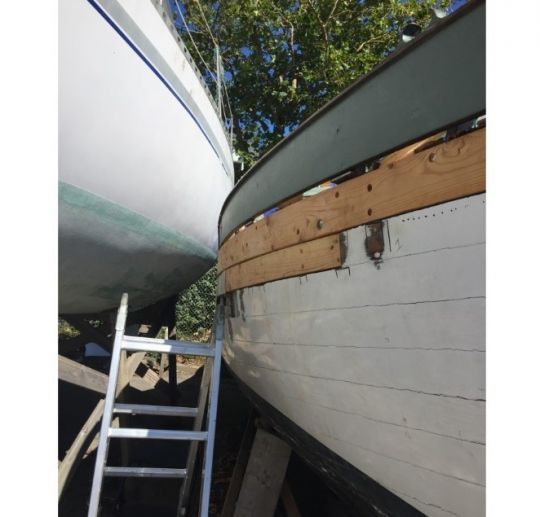
The bow is straight, the reefing correct and the transom openwork. Hemp oakum caulking has completely replaced the cotton caulking on the port hull, and only the brightwork on the starboard side.
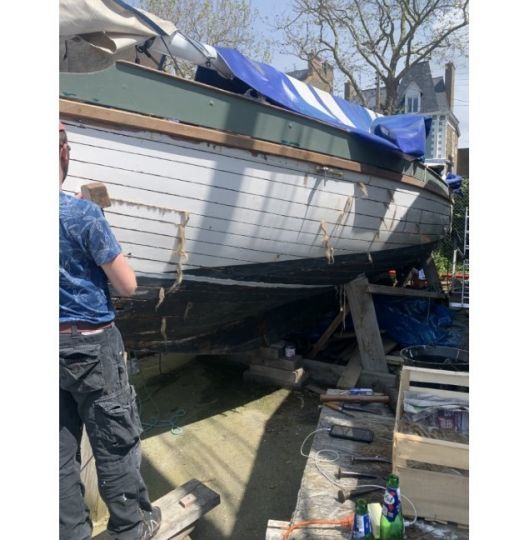
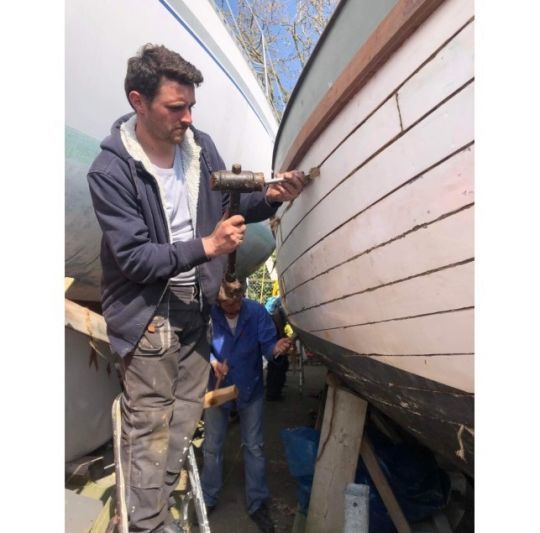
The deck is made of 12 mm marine plywood. The forward part of the coachroof is new. The gunwales have been completely replaced by a sapele gunwale, raised 5 mm above the original to be flush with the deck, thus avoiding water stagnation.

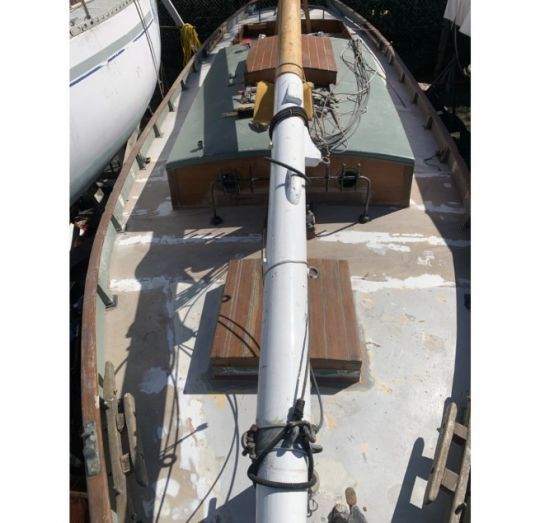
The deck rests on a set of oak barrots and rubrails, 2 of which have been replaced with ash heartwood.
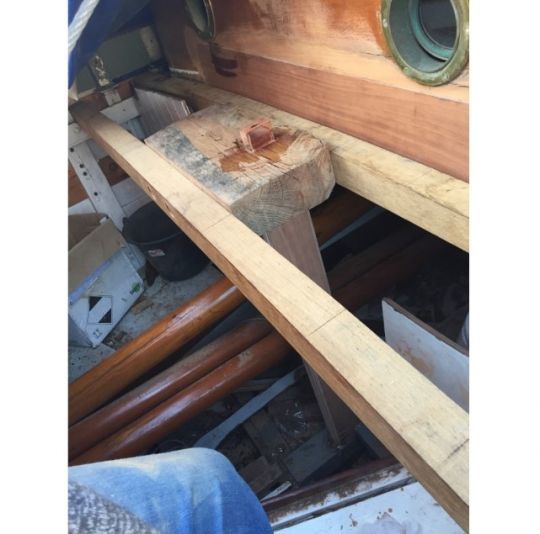
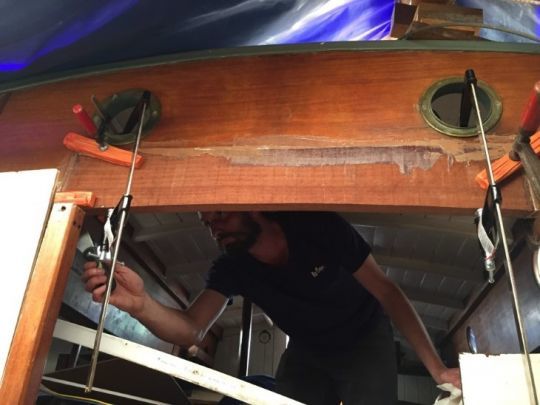
The rig is of the auric type, with a glulam spruce mast dating from 1984. All spars (bowsprit, peak and boom) are spruce. The glulam helm has been replaced by a solid iroko helm, slightly thinner and lower to preserve the boat's line. The chainplates consist of 3 bronze outer plates, bolted in stainless steel through the gunwale, the bowsprit and the first 3 planks. Inner chainplate wedges are made from ash heartwood. The forestay, whiskers and sub-bard are in stainless steel. The runners are taken up using a 2-sheave tackle on a 5-point bronze chainplate. The mast sponge is new, mortise and tenon jointed on a spar. Jean says he has slightly broken the rules here by using CP Marine glulam, a method that doesn't conform to tradition. Nevertheless, from the point of view of compressive strength, it was necessary. The sails include an 82 m² dacron mainsail from the 90s, a 6 m² jib and 5 m² staysail in cotton, and an 18 m² balloon jib in nylon. The 8 HP Yanmar YS8 engine, which dates back to the 80s, has been overhauled.
Jean is grateful to all his friends for their support and participation in the work. At the launch, he explains that a thin trickle of water had seeped on board: '' Perfectly normal, just long enough for the wood to swell. Madeline had spent 4 years on land. I had provided 4 pumps in case of need, but they weren't needed... Even the guys on site were surprised ''.
In 2024, Jean and his girlfriend formed the "Voiles Traditionnelles Bretonnes" association. Together, they organize regular outings for members, while maintaining Madeline.
